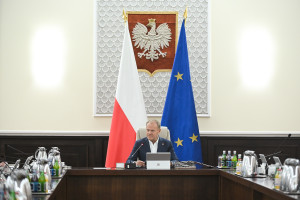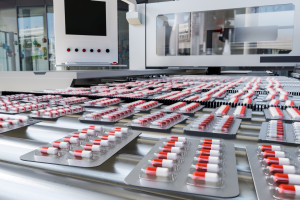7000 PLN per gram. Polish meat of the future is still expensive, but promising

- Consulting firm McKinsey & Company estimates that the lab-grown meat production market will be worth about $25 billion in 2030.
- There are almost 200 companies worldwide that deal with meat farming. One of them is located in Poland.
- - Cell culture is not intended to replace traditional meat, but to supplement it - as a solution to the problem of lack of space and resources - says Katarzyna Roszkowska, laboratory research specialist at LabFarm
- The cost of producing the first lab-grown beef burger in 2013 was estimated at $330,000
- Currently, the estimated cost of producing one kilogram of meat in fully optimized conditions is about $20
Singapore lacks vast pastures and fields, so it imports most of its food. During the COVID-19 pandemic, when supply chains were disrupted, it turned to alternative ways to secure access to food.
There was a boom in start-ups working on the production of proteins using plant, fungal or animal extracts, including laboratory-grown meat from animal cells. The choice of "materials" for further processing is large: chicken, seafood, quail, beef, pork, fish.
Singapore was also the first country to allow the sale of lab-grown meat products in 2020. The United States and Israel followed suit, and the United Kingdom approved such products for use in pet food.
Today, cell-cultured meat can be found in Singaporean stores, although due to cost reasons, these are hybrid products containing some cultured meat (less than 10 percent) and the rest are plant-based components, which allows for the price to be reduced to the level of conventional meat.
The price of this invention is key. The cost of producing the first lab-grown beef burger in 2013 was estimated at $330,000. And what are the prices like today?
- The current estimated cost of producing one kilogram of meat in fully optimized conditions is around $20. In the case of our prototype produced for research purposes, the cost was PLN 7,000 per gram, which resulted from the need to use commercial, very expensive media and a small scale of production - says Katarzyna Roszkowska, laboratory research specialist at LabFarm*.
The company's main investor is Jarosław Krzyżanowski, owner of a poultry company. Inspired by the idea of avoiding the suffering of farm animals, he invested in a laboratory where a meatball made of poultry cellular meat was created in less than 2 years. In 2022, the first Polish prototype of cellular meat was presented during the ProVeg New Food Forum.
Recipe for cell-cultured meatThe production process is similar to drug development – the same tissue engineering techniques used to make drugs and vaccines are used to create meat. Animal tissue and fat are grown in the lab from cells and then processed into different proteins.
Katarzyna Roszkowska describes the process of creating meat in the LabFarm laboratory: - First, a sample is taken from the animal's tissue. The next phase is the isolation of fat cells, muscle cells and connective tissue, and then the creation of a stable cell line, constantly proliferating, to eliminate the need to collect the material again.
Then the cells are grown in bioreactors simulating the conditions inside the animal's body. The process is fully automated and scalable to very large volumes, similar to the pharmaceutical industry. Once the biomass is produced, it is formed into the final product.
- The entire process – from cell multiplication to obtaining the finished product – takes from 1 to 2 weeks – emphasizes the expert.
What will be on the label of such a product? - All meat ingredients are identified based on the nutrients found in the cell culture medium - he says.
He emphasizes that the cell-based meat industry is interdisciplinary and combines technologies from the pharmaceutical sector with components from the food industry. As in pharmaceuticals, patents come into play, which protect the innovator.
- The largest number of patents concern bioreactors, media formulas and biomaterials for shaping the product. Technological innovations in the production of our own media and methods of scaling up to an industrial level allow for simplification and reduction of the costs of the development and production process - he explains.
The company is a beneficiary of a grant from the National Centre for Research and Development.
We are waiting for the first Polish tasting- This grant gives us new tools to optimize the process, to make it much cheaper. It is also about increasing the scale, because we plan to move from a 3-liter bioreactor to a 50-liter bioreactor. Thanks to this, we will be able to produce much more. In terms of the product development phases and the development plan, we are still in the research phase. Next year we plan to build a 500-liter scale, and in 2027 we will enter the industrial scale - says Katarzyna Roszkowska.
For now, however, meat produced in this way cannot even be tried in Poland.
- Currently, tastings of this type of product are significantly hampered by the lack of clear regulations. In order to legally try the product, it would have to be exported abroad, to countries such as the Netherlands or the United States, where regulations in this area are more developed. Work is currently underway to determine how to legally organize a tasting - says a representative of the company.
He hopes that the development of lab-grown meat will be followed by a change in regulations. Especially since, as he argues, cell-cultured meat can be an alternative for people who avoid meat for ethical or health reasons. Apart from the initially collected tissue, it does not contain any other animal ingredients.
- The production process is carried out using methods that are fully controlled from start to finish. At every step, we know what ingredients were used, how the meat is raised, in what environment. Everything is done in sterile conditions, so there is no need to use antibiotics. In addition, it solves problems related to climate change and lack of resources, which hinder the further development of traditional agriculture. The production of the product in the laboratory itself takes less time than breeding an animal, and its production uses less water and energy. Such production also reduces greenhouse gas emissions into the atmosphere - he lists the advantages.
- But – as he emphasises – cell culture is not intended to replace traditional meat, but to supplement it – as a solution to the problem of lack of space and resources.
Global Lab Meat MarketSingapore remains a pioneer and leader in this field. There are about 12 alternative food startups operating there, according to a 2024 publication, “ Singapore doubles down on lab-grown meat as Silicon Valley backs off,” on restofworld.org.
There are almost 200 companies involved in cultured meat worldwide. Apart from Singapore, the leaders are companies from Europe (mainly the Netherlands and France), the United States, South Korea, Israel and Hong Kong. There is also interest from Australia and New Zealand, China, Saudi Arabia and the United Arab Emirates.
Consulting firm McKinsey & Company estimates that this market will be worth about $25 billion in 2030.
* Katarzyna Roszkowska's statement was recorded during a conference organized by the Patent Office of the Republic of Poland on the occasion of the Polish Presidency of the EU Council "Biotechnological innovation for a sustainable future" (Krakow, 20-21 May 2025).
Copyrighted material - reprint rules are specified in the regulations .
rynekzdrowia













